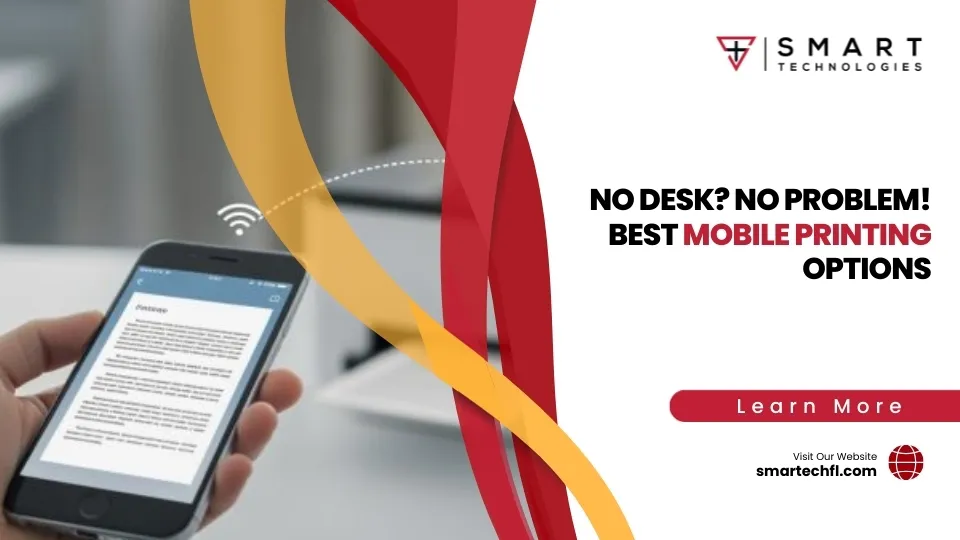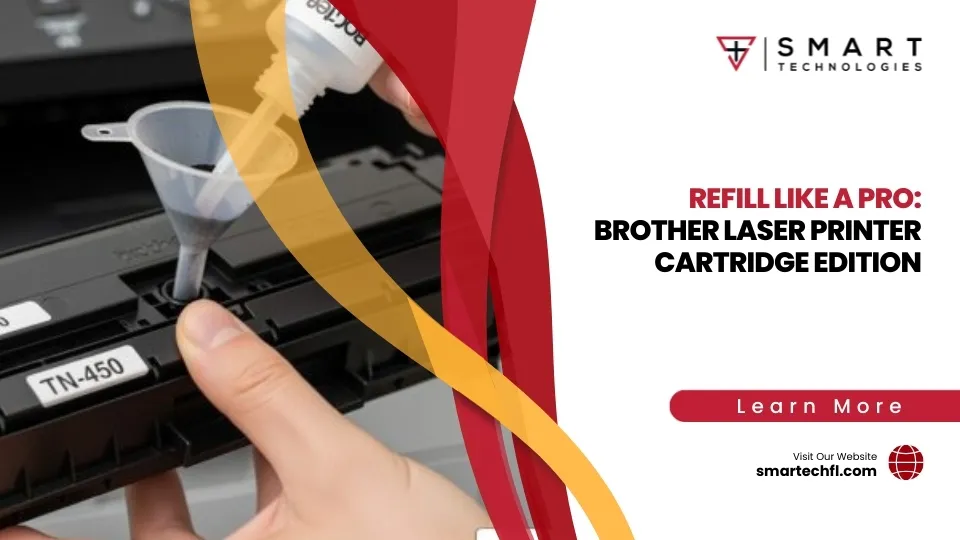Print Smarter, Not Harder: Sustainable Printing Solutions Explained
Sustainable printing solutions are eco-friendly printing methods that reduce environmental impact while maintaining quality and cost-effectiveness. Here’s what you need to know:
Key Sustainable Printing Solutions:
- Digital printing – eliminates plates and chemicals, reduces waste
- Recycled paper – uses 5-7 recyclable paper stocks, saves 17 trees per ton
- Eco-friendly inks – soy, vegetable, or water-based alternatives to petroleum inks
- Energy-efficient equipment – ENERGY STAR printers with sleep modes
- Print management software – tracks usage, reduces waste by up to 50%
- Carbon offsetting – reforestation programs to balance environmental impact
Your customers are paying attention. 55% of consumers will pay more for eco-friendly brands, while 84% say poor environmental practices will drive them away from your business entirely.
But here’s the thing – sustainable printing isn’t just about keeping customers happy. It’s about cutting costs too.
The numbers tell the story: 65% of printed documents get thrown away the same day they’re printed. The average office burns through 50kg of paper annually. Print-related expenses eat up about 3% of your company’s budget.
Smart businesses are already making the switch. Products marketed as sustainable grew 2.7 times faster than traditional alternatives. With ESG-themed investments expected to surpass $41 trillion, sustainable practices aren’t just nice-to-have anymore – they’re essential for staying competitive.
The paper industry ranks as the 4th biggest contributor to greenhouse gases globally. Every printing decision your business makes either adds to this problem or helps solve it.
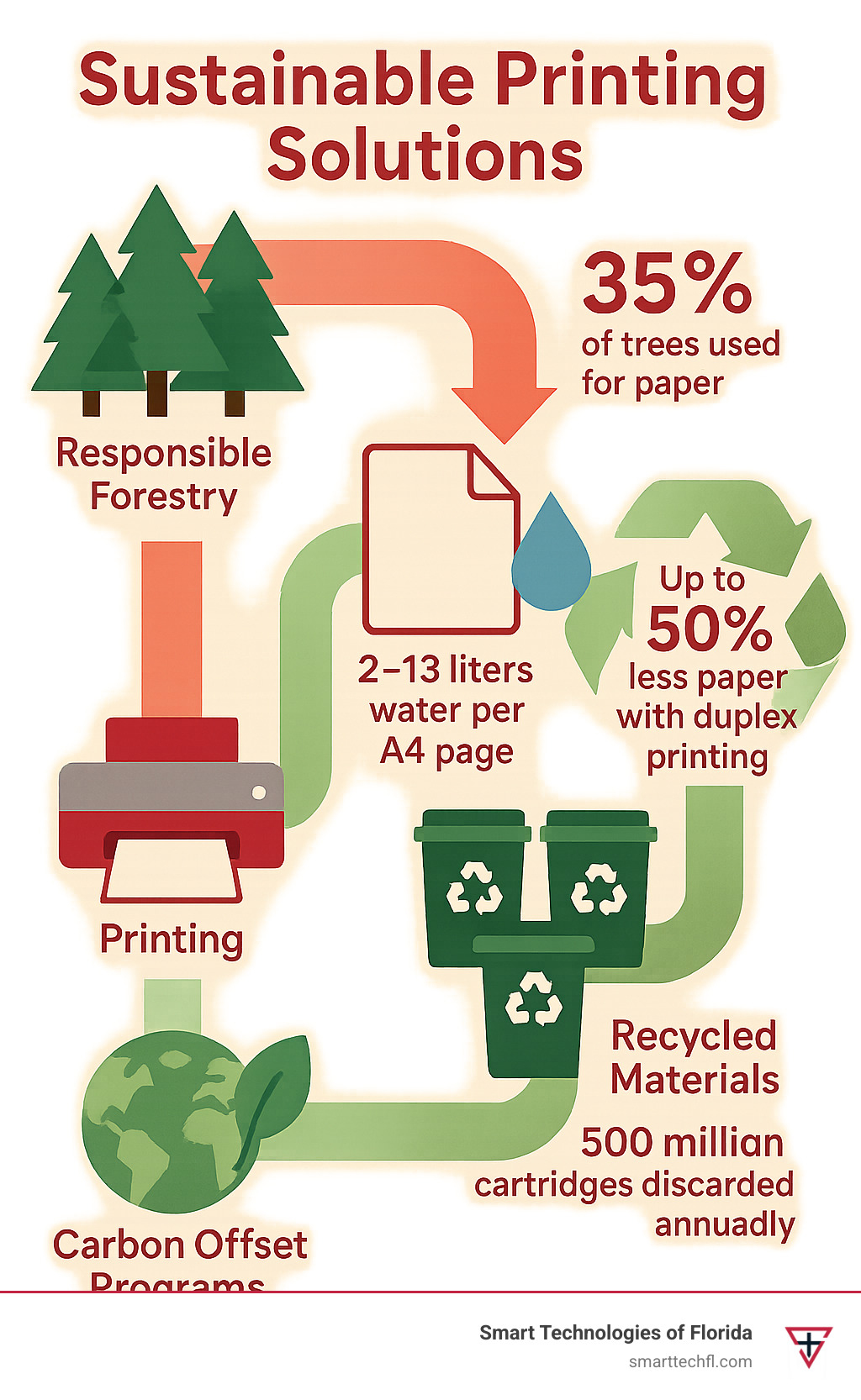
The Paper Puzzle: From Trees to Toner
Let’s start with the uncomfortable truth: 35% of all harvested trees end up as paper. That’s not a typo – more than one-third of our forests become the documents sitting on your desk.
But the environmental impact doesn’t stop at deforestation. Every single A4 sheet requires between 2 and 13 liters of water to produce. Think about that the next time you’re printing a 50-page report.
Then there’s the energy drain. Traditional printing processes are energy-hungry beasts, consuming massive amounts of electricity for everything from paper production to ink manufacturing.
The Promise of Sustainable Printing
Sustainable printing solutions aren’t just about feeling good – they’re about smart business strategy.
When you implement eco-friendly printing practices, you’re tapping into powerful market forces. Customers increasingly choose brands that align with their environmental values. This isn’t just marketing fluff – it’s measurable brand loyalty that translates directly to your bottom line.
Regulatory compliance is another win. As governments worldwide tighten environmental regulations, businesses with established sustainable practices stay ahead of the curve.
The triple bottom line – people, planet, and profit – becomes achievable when you accept sustainable printing.
Why Sustainable Printing Matters
Let’s talk numbers. The environmental impact of traditional printing might shock you, but understanding these facts is the first step toward making smarter business decisions.
Every year, 35% of all harvested trees end up as paper products. When you choose recycled paper instead, you’re literally saving trees. Each ton of recycled paper rescues 17 trees from the chopping block, plus saves 1,440 liters of oil and 4,000 kilowatts of energy.
The water story gets even more eye-opening. That single A4 page you just printed? It required 2-13 liters of water to produce. Your typical office using 10,000 sheets annually consumes enough water to fill a backyard swimming pool – just for paper production.
Here’s something that might make you wince: Over 500 million ink cartridges hit landfills every single year. These plastic and metal cartridges can take up to 1,000 years to break down, slowly leaching toxic chemicals into our soil and groundwater.
Your wallet feels this impact too. Print-related expenses eat up about 3% of most companies’ budgets. For a mid-size business, that translates to thousands of dollars annually.
Your customers are watching. 55% of consumers actively seek out eco-friendly brands and will gladly pay more for sustainable products. But here’s the flip side: 84% of consumers will walk away from companies with poor environmental practices.
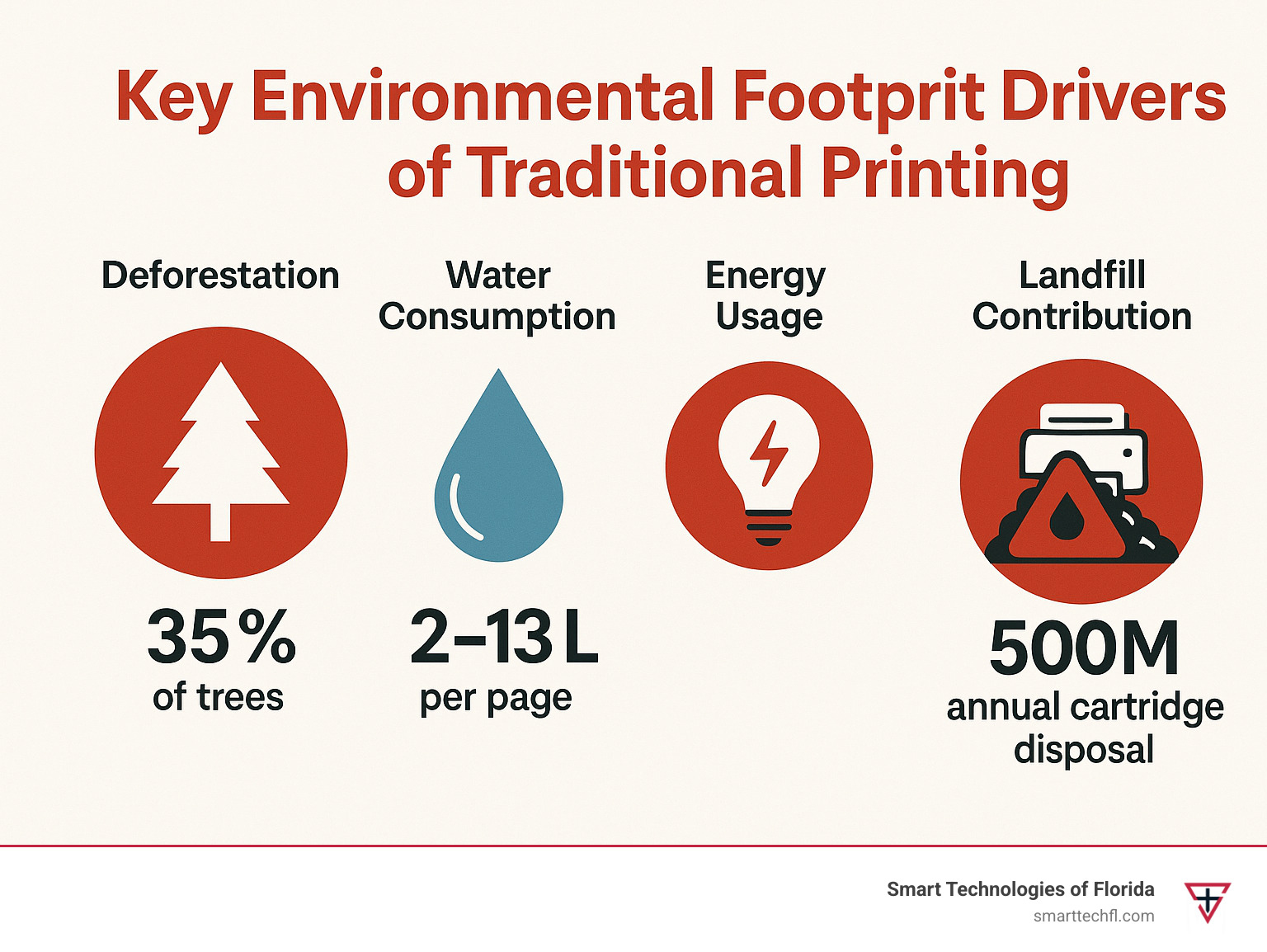
The Business & Planet Payoff
Sustainable printing solutions don’t just help the environment – they boost your bottom line in ways that might surprise you.
The cost savings start immediately. Simple changes like duplex printing cut paper consumption in half. Print management software eliminates wasteful printing habits. Energy-efficient equipment slashes electricity bills, and modern sustainable printers break down less often, reducing IT support calls.
Your team becomes more productive too. Today’s eco-friendly printing solutions come packed with smart features like cloud connectivity, mobile printing, and automated maintenance alerts.
Your company’s reputation gets a measurable boost. ESG scores directly impact how investors, partners, and customers view your business. With ESG-themed investments expected to surpass $41 trillion, having strong environmental credentials isn’t just good karma – it’s essential for accessing capital and winning premium contracts.
Key Barriers to Overcome
The upfront costs concern is real. Some eco-friendly equipment and materials do cost more initially. But total ownership costs almost always drop within 12-18 months. The key is looking beyond sticker prices to calculate real long-term value.
Knowledge gaps trip up many business owners. The trick is asking vendors for specific, measurable environmental benefits. If they can’t explain exactly how much water, energy, or waste their solution saves, keep shopping.
Greenwashing is unfortunately common in the printing world. Look for third-party certifications like ENERGY STAR, FSC, or ISO 14001. Trust vendors who provide transparent reporting and measurable metrics, not just feel-good marketing language.
Core Sustainable Printing Solutions
Think of sustainable printing solutions as building blocks that work together to transform how your business approaches printing. It’s not about making one big change – it’s about implementing smart strategies that reduce waste, save money, and protect the environment.
The circular economy approach changes everything. Instead of the old “buy, use, throw away” model, we’re talking about systems where materials keep cycling through useful purposes. Your ink cartridges get refilled instead of tossed. Your paper comes from recycled sources and gets recycled again.
Print-on-demand technology is a game-changer for businesses tired of storage rooms full of outdated materials. Why print 1,000 brochures when you might only need 50? Modern digital printing lets you produce exactly what you need, exactly when you need it.
Here’s something that takes most business owners by surprise: setting duplex printing as your default can cut paper use in half overnight. It’s such a simple change, but most offices never bother to make it.
Print management software takes this concept further by tracking who’s printing what, when, and how much. You’ll finally get answers to questions like “Why is our paper budget so high?”
| Traditional Printing | Sustainable Printing |
|---|---|
| Single-sided default | Duplex default (50% paper reduction) |
| Petroleum-based inks | Soy/vegetable-based inks (biodegradable) |
| Virgin paper only | Recycled/FSC-certified paper |
| Individual cartridges | Refillable tanks/remanufactured supplies |
| No usage tracking | Print management software monitoring |
| Landfill disposal | Recycling/carbon offset programs |
Sustainable Materials: Paper & Substrates
The paper you choose matters more than you might think. FSC-certified paper comes from forests managed with strict environmental and social standards. Scientific research on responsible forestry shows that properly managed forests actually support biodiversity while providing sustainable timber harvests.
Recycled paper has come a long way from the gray, rough stuff you might remember. Modern recycled papers often match virgin paper quality while costing less. Most paper can be recycled 5-7 times before the fibers become too short for reuse. Every ton of recycled paper saves 17 trees, 1,440 liters of oil, and 4,000 kilowatts of energy.
Alternative fiber papers open up exciting possibilities beyond traditional wood pulp. Cotton papers offer beautiful texture and durability while using textile waste. Hemp paper provides exceptional strength and requires fewer harsh chemicals to process.
Carbon Balanced Paper takes sustainability to the next level. Every ream you purchase funds forest conservation projects that offset the carbon emissions from paper production.
The top eco-friendly paper options include 100% recycled content paper made from post-consumer waste, FSC-certified virgin paper from sustainable forests, tree-free papers made from bamboo, hemp, or cotton, Carbon Balanced Paper with verified offset projects, and chlorine-free bleached papers that eliminate toxic chemicals from production.
Sustainable Inks & Toners—From Soy to Refillable Tanks
Traditional petroleum-based inks contain volatile organic compounds (VOCs) that harm both environmental and human health. Sustainable ink alternatives often work better than the old-fashioned stuff.
Soy-based inks have become the gold standard for many printing applications. They’re made from renewable soybeans, contain minimal VOCs, and actually make paper recycling easier because they de-ink more readily. Colors often appear more vibrant too.
Water-based inks eliminate VOCs entirely and reduce the need for harsh cleaning solvents. They’re particularly effective for digital printing applications where environmental concerns are paramount.
Algae-based inks represent the cutting edge of sustainable printing. They’re actually carbon-negative because algae absorbs CO2 during growth.
Cartridge refills and continuous ink tank systems slash both costs and waste. Instead of throwing away entire cartridges, you simply refill them. Quality remanufactured cartridges perform identically to originals while costing 30-50% less.
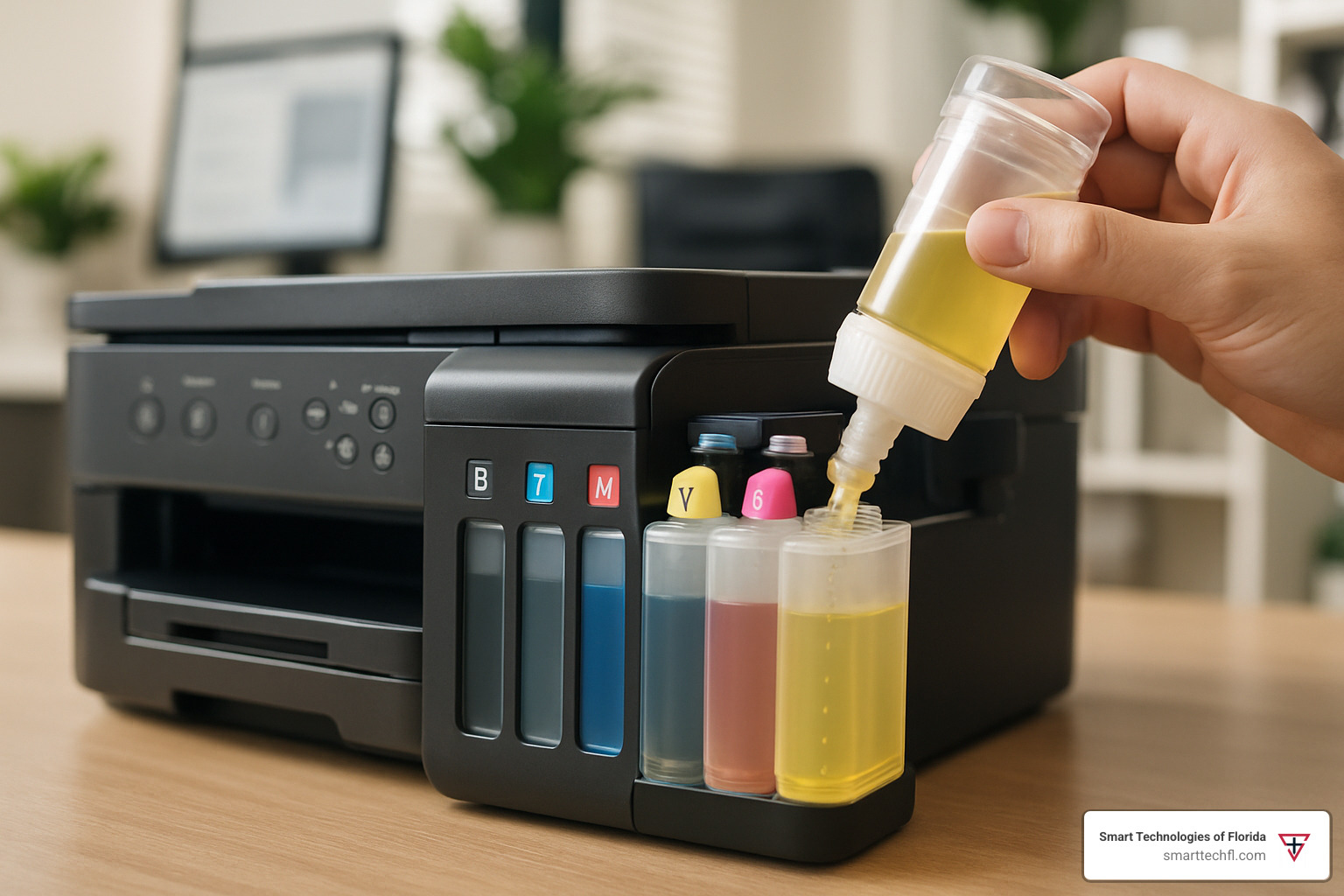
Energy-Efficient Equipment & Technologies
Modern printing equipment offers remarkable energy efficiency improvements that translate directly to lower utility bills. ENERGY STAR certified printers use 30-75% less energy than older models, with smart sleep modes that activate within minutes of inactivity.
Multifunction printers (MFPs) make perfect sense for most businesses. Why have separate devices for printing, scanning, copying, and faxing when one machine can handle everything? This consolidation reduces overall energy consumption, maintenance requirements, and physical footprint.
LED-UV curing technology eliminates mercury-vapor lamps and reduces energy consumption by up to 70% compared to traditional UV systems. The process also eliminates toxic chemicals while delivering superior print quality.
Digital plate-less printing processes eliminate the waste and chemicals associated with traditional offset printing plates. For short to medium print runs, digital printing often uses less energy and produces less waste than offset alternatives.
Advanced printing features in modern equipment include intelligent toner usage optimization, automatic color management, and predictive maintenance alerts that prevent waste and downtime.
Managing & Measuring for Continuous Improvement
Here’s the truth about sustainable printing solutions: if you can’t measure it, you can’t manage it. That’s where print management software becomes your secret weapon for cutting both costs and environmental impact.
Think of print management software as your printing detective. It quietly tracks everything happening across your office – who’s printing what, when they’re printing it, and exactly how much it’s costing you (and the planet).
One client found that 40% of their color printing could easily be done in black-and-white without any impact on effectiveness. Another found that three departments were printing the same monthly reports separately instead of sharing one copy.
Modern systems monitor pages printed by user and department, track color versus black-and-white usage, measure paper and toner consumption, and calculate energy usage. This comprehensive view helps you spot waste patterns and opportunities for improvement.
The real game-changer happens when you implement usage quotas and charging systems. When people see the actual cost of their printing choices, behavior changes fast.
Carbon tracking software like CarbonQuota takes measurement to the next level by calculating the environmental impact of every single print job. Users see real-time CO2 emissions data right on their screens, making environmental impact as visible as financial costs.
Sustainable printing practices require ongoing attention and adjustment. Regular audits help identify new opportunities for improvement.
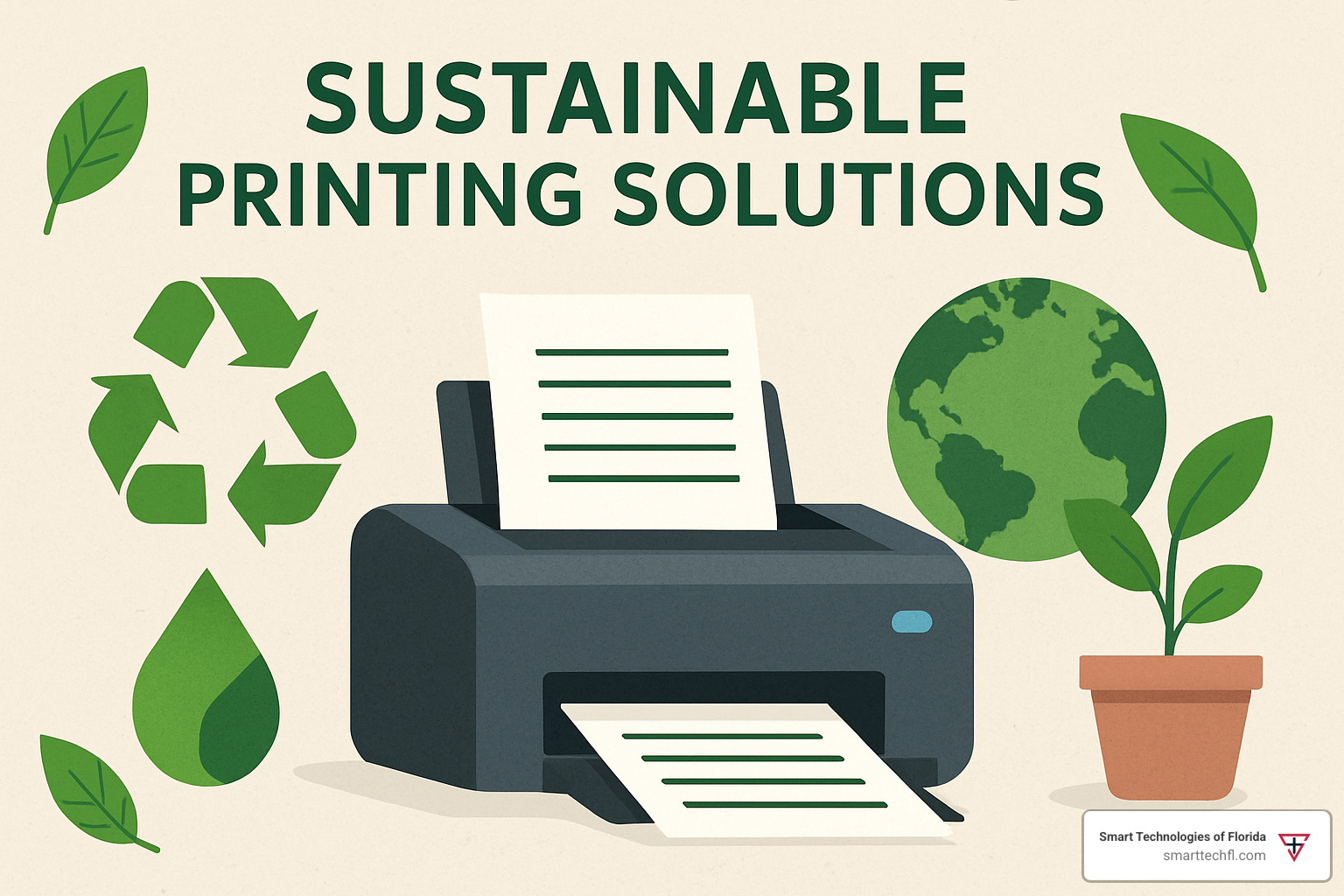
Sustainable Printing Solutions Metrics & Certifications
Understanding your environmental impact means looking beyond just the paper and ink you use. Scope 3 emissions – the indirect emissions from your supply chain – often represent the biggest chunk of your printing-related carbon footprint.
The difference between carbon neutral and carbon balanced printing matters. Carbon neutral means calculating your total emissions and buying verified carbon offsets to balance them out. Carbon balanced goes further by supporting projects that provide additional environmental and social benefits.
When evaluating sustainable printing options, look for these key certifications. ISO 14001 shows a company has proper environmental management systems in place. FSC certification guarantees responsible forestry practices. The Nordic Swan ecolabel covers comprehensive environmental criteria, while ClimatePartner certification demonstrates serious carbon management efforts.
CarbonQuota channel partners offer integrated carbon tracking and offsetting solutions that make sustainability measurement automatic rather than a manual headache.
Life-cycle analysis takes the broadest view possible, considering environmental impact from raw material extraction all the way through disposal. This comprehensive approach often reveals surprising insights about which printing choices truly minimize environmental impact.
Offsetting & Giving Back
Even with the most efficient sustainable printing solutions, some environmental impact remains. Carbon offsetting programs help you achieve net-zero or even carbon-negative printing by funding projects that actively remove CO2 from the atmosphere.
PrintReleaf offers automated reforestation programs designed specifically for the printing industry. For every ream of paper your business uses, trees get planted in certified reforestation projects around the world.
Carbon credits support verified projects like renewable energy development, methane capture, and forest conservation. Quality matters here – look for credits certified by recognized standards like Verra or Gold Standard.
The World Land Trust’s Carbon Balanced Paper program provides a way for businesses to balance their paper impacts while supporting biodiversity conservation. Every ton of carbon balanced paper helps protect critical habitats in Vietnam, Mexico, Ecuador, and Guatemala.
Trees Water & People combines reforestation with community development, providing sustainable livelihoods while restoring degraded landscapes. These programs deliver measurable environmental and social returns on your investment.
Future Trends & Success Stories
The world of sustainable printing solutions is moving faster than ever. What seemed impossible just a few years ago is now becoming standard practice in forward-thinking businesses.
Take LED-UV printing technology, for example. It started in high-end commercial printing shops, but now it’s making its way into regular office environments. The energy savings alone are impressive – we’re talking about 70% less power consumption compared to traditional UV systems.
Here’s something that sounds like science fiction but is actually happening right now: algae-based inks. These aren’t just carbon-neutral – they’re actually carbon-negative. The algae literally sucks CO2 out of the air while it’s growing.
The smart technology integration is where things get really interesting. On-press AI diagnostics can spot problems before they happen, automatically adjust settings to prevent waste, and even predict when your equipment needs maintenance.
Blockchain traceability might sound overly technical, but it’s solving a real problem. Your customers can now scan a QR code and see exactly where their printed materials came from – which forest, which mill, even which environmental projects their purchase supports.
The circular economy approach is gaining serious momentum. Companies like HP have already used over 1 billion pounds of recycled materials in their products and packaging since 2019.

Innovations Reshaping Sustainable Printing Solutions
The technology innovations happening behind the scenes are just as impressive. Digital twin technology creates virtual copies of your entire printing operation, letting you test changes and optimizations without affecting your actual workflow. The results speak for themselves – 2-6% energy reductions while actually improving print quality.
IoT energy sensors are like having a personal energy coach for your print fleet. They monitor power consumption in real-time, identify which devices are energy hogs, and can even automatically shut down equipment that’s sitting idle.
The shift to cloud-based workflows eliminates bulky print servers and makes mobile printing seamless. Plus, remote firmware updates mean your equipment gets smarter and more efficient over time without requiring service calls.
Real-World Wins
Let’s talk about businesses that are actually making this work, because real results matter more than fancy promises.
Acorn Web integrated carbon tracking software directly into their management system and saw something remarkable happen. Their turnover jumped from £16 million to £26 million while simultaneously reducing their carbon footprint. The transparency around their environmental impact helped them win bigger contracts.
A sports charity switched to the P4TP (Print for the Planet) subscription service and found that sustainable printing actually simplified their operations. The fixed billing made budgeting easier, and the carbon-neutral equipment eliminated their printing-related emissions entirely.
Smartpress achieved ISO 14001 certification and EcoVadis Platinum status – that puts them in the top 1% of companies in their industry for sustainability. Their waterless digital printing saves thousands of gallons of water every year.
What’s interesting about these success stories is they all share the same key ingredients: careful measurement and tracking, genuine employee engagement, and partnerships with vendors who actually care about sustainability.
The message is clear – sustainable printing solutions aren’t just good for the planet anymore. They’re becoming essential for businesses that want to stay competitive, attract top talent, and build lasting relationships with environmentally conscious customers.
Frequently Asked Questions about Sustainable Printing Solutions
You’ve probably got questions about making the switch to sustainable printing solutions. We hear these same concerns from business owners every day, so let’s tackle the big ones head-on.
What are the most eco-friendly printing methods today?
If you’re looking for the greenest options available right now, LED-UV printing is your champion for commercial work. This technology ditches those energy-hungry mercury-vapor lamps and slashes energy use by up to 70%. Plus, it eliminates toxic chemicals entirely while actually improving print quality.
Digital printing deserves serious consideration too, especially for everyday office needs. Think about traditional offset printing – all those plates, films, and chemical baths. Digital printing skips that entire messy process. For most business printing needs, digital methods generate less waste and consume less energy.
Waterless printing might sound too good to be true, but it’s real and it works beautifully. Traditional printing guzzles thousands of gallons of water. Waterless systems deliver the same quality without a single drop wasted.
How do eco inks differ from conventional petroleum inks?
The difference starts with what’s floating around in the air after printing. VOC content – those volatile organic compounds – are the troublemakers in petroleum-based inks. They contribute to air pollution and can cause headaches and respiratory problems. Soy, vegetable, and water-based inks either eliminate VOCs completely or reduce them to barely measurable levels.
Biodegradability varies wildly between ink types. Eco-friendly inks break down naturally in composting systems, becoming harmless organic matter. Petroleum inks can hang around in landfills for decades, slowly leaching chemicals into soil and groundwater.
The recycling story gets even better. De-inking during paper recycling becomes much easier with eco-friendly inks. This means your recycled paper maintains higher quality through more recycling cycles.
Is switching to sustainable printing expensive?
This is the million-dollar question, isn’t it? Here’s the honest truth: some sustainable materials do cost more upfront. But when you look at total cost of ownership – the real number that matters to your bottom line – sustainable printing typically costs less over time.
Let’s break down where the savings come from. Duplex printing alone cuts your paper costs in half immediately. Energy-efficient equipment reduces those monthly electricity bills. Print management software eliminates waste and reduces IT troubleshooting time.
Most businesses see quick ROI within 12-18 months. The savings come from multiple directions: reduced material costs, lower energy bills, decreased waste disposal fees, and less staff time spent dealing with printing issues.
The biggest surprise for many business owners? Print volume cuts often provide the largest savings. When employees become aware of printing costs and environmental impact, unnecessary printing drops dramatically. We’ve seen organizations reduce total print volume by 30-50% without affecting productivity.
Conclusion
The path to sustainable printing solutions doesn’t have to be complicated or overwhelming. After helping businesses in Daytona Beach and beyond for 23 years, we’ve learned that the most successful changes happen when you focus on people first, technology second.
Here’s what we know for sure: the environmental crisis is real, your customers care about sustainability, and your printing choices make a measurable difference. But here’s the part that might surprise you – sustainable printing solutions often save money while helping the planet.
At Smart Technologies of Florida, we believe in making complex changes feel manageable. Our people-centric approach means we don’t just drop new equipment on your desk and walk away. We work with your team to understand your unique needs, train your employees, and create sustainable practices that actually stick.
The transition can start small. Maybe you begin by setting duplex printing as your default – boom, you’ve just cut paper consumption in half. Add some print management software to track where waste happens. Switch to recycled paper when your current stock runs out. These simple changes create momentum for bigger improvements.
What really matters is building sustainability into your company culture. When employees understand the impact of their printing choices, behavior changes naturally. When they see real data showing how much money and resources you’re saving, they become champions of the program.
Employee training makes all the difference. We’ve seen organizations achieve 30-50% reductions in print volume simply by helping people understand the true costs – both financial and environmental – of their printing decisions. It’s not about restricting people; it’s about empowering them with information.
Continuous monitoring keeps the momentum going. Those dashboards showing CO₂ per print job aren’t just pretty graphs – they’re conversation starters. They help teams celebrate wins and identify new opportunities for improvement.
The businesses that succeed with sustainable printing solutions treat them as part of their broader strategy, not as isolated projects. They align environmental goals with business objectives and measure success in both dollars saved and carbon reduced.
Your journey starts with a single step. Maybe it’s auditing your current practices to see where the biggest opportunities lie. Maybe it’s implementing that print management software you’ve been considering. Or maybe it’s simply having a conversation with your team about why sustainability matters to your business.
The technology is ready. The financial benefits are proven. Your customers are waiting. The only question left is: are you ready to make printing a competitive advantage for your business?
We’re here to help make it happen. Our printers & copiers services include everything you need to create a sustainable printing strategy that works for your business, your budget, and our shared planet.





